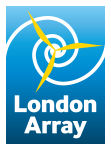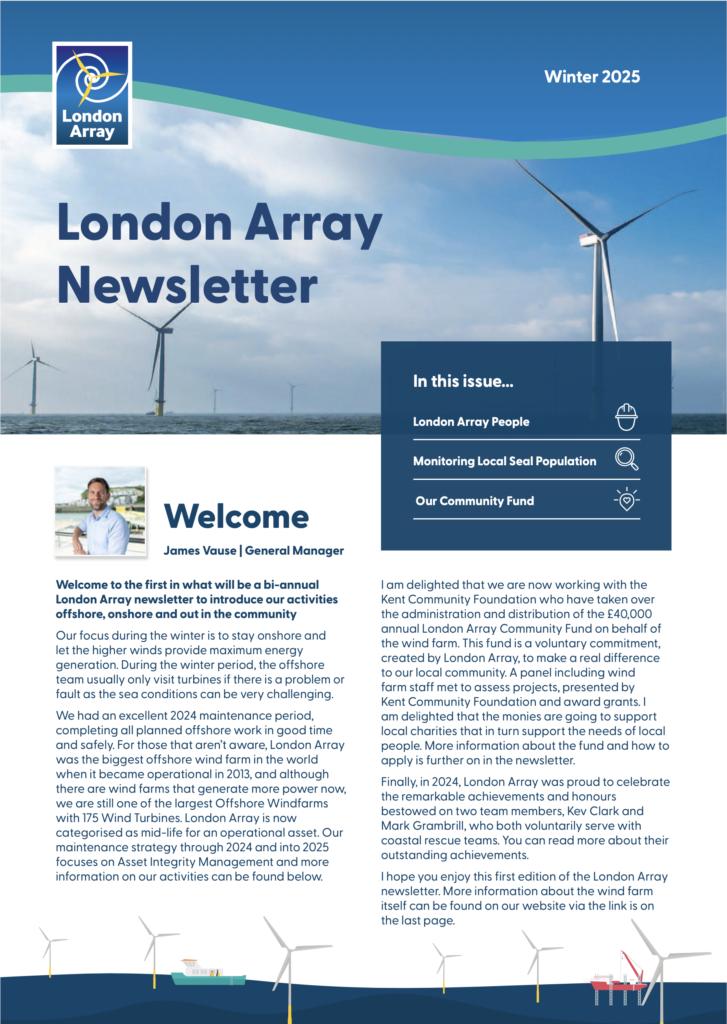

At the time of its inauguration in 2013, London Array was the largest offshore wind farm in the world. Its conception and construction attracted international attention, and paved the way for the current generation of even larger wind farms being built around Britain’s coastline. London Array continues to be at the forefront of innovation in the production of offshore renewable energy.
Located 20km off the north Kent coast in the Outer Thames Estuary, London Array has a 630MW capacity and generates enough clean electricity to power around 584,000 UK homes, while displacing around 900,000 tonnes of CO2 a year. It is maintained and operated from the Port of Ramsgate.
Facts & Figures
Located 20km off the north Kent coast in the Outer Thames Estuary
An offshore area of 100km2
175 wind turbines
Two offshore substations
Maintained and operated from the Port of Ramsgate.
Nearly 450km of offshore cabling
Generates enough clean electricity to power around 584,000 British homes.
One onshore substation
630MW of electricity
A reduction in harmful CO2 emissions of around 925,000 tons per year
How The Wind Farm Works

Wind turns the blades on each individual wind turbine to generate electricity.
London Array features 175 Siemens 3.6MW wind turbines with a combined capacity of 630MW. Arranged in rows and columns aligned according to the prevailing south-westerly wind, they are placed 650m to 1,200m apart and cover an area of 100sq km. Each turbine’s hub is 87m above sea level, and to the tip of the blade at its highest point is around 147m, taller than the London Eye. With a diameter of 120m, the blades have a swept area of 11,300m2 – one and a half times the size of Wembley Stadium’s football pitch.
The blades, which are made of fibreglass-reinforced epoxy, capture the power of the wind, causing them to rotate. Each blade has its own independent pitching mechanism capable of changing the angle of the blade – or feathering – under any operating condition. This optimises power output when the turbines are generating and minimises stress from wind when they are shut down. The turbines start generating electricity when wind speeds reach 3 metres per second (m/s) or around 7mph. They achieve full power from 13m/s (around 29mph). For safety reasons, the turbines will start shutting down if the wind speed becomes greater than 25m/s – equivalent to a force 9 gale. The turbines are turned into the wind by a motorised yaw mechanism.
The blades rotate the rotor to which they are fixed, which in turn spins the main shaft. Made of forged alloy steel, the main shaft is attached to the rotor with a flange connection. The shaft goes into a three-stage gearbox to increase speed before the generator converts the rotational energy into electrical energy. The electricity produced then passes through the turbine’s transformer and is stepped up to 33kV for export to the offshore substations. A remote control system monitors the vibration level of the main components. Detailed analysis and reprogramming can all be carried out using a standard web browser. The turbines are designed to run for more than 20 years, 24-hours-a-day, seven-days-a-week.
Array cables buried in the seabed take the electricity from the wind turbines to the offshore substations.
Buried in the seabed lies more than 200km of array cabling linking the turbines to each other and to the offshore substations. Every one of the 187 array cables was individually cut to suit its location and varies in length from 720m to 3,110m. Every metre weighs 50kg.
As well as three power cores carrying the 33kV electricity generated by the turbines, the cables also contain fibre optic cores allowing the turbines to be monitored and controlled remotely. The cables are buried approximately 1.5m under the seabed and rise via protective J-tubes at the substation and turbine foundations. They were manufactured by JDR Cable Systems in Hartlepool.
The offshore substations boost the voltage to reduce transmission losses.
Set among London Array’s 175 turbines are two identical offshore substations, located either side of the site and some 6.5km apart.
The substations receive the electricity generated by the turbines at 33kV. A network of undersea cables connects strings of turbines to each other and then, via 12 final cables, to the two offshore substations.
Utilising off-shore substations enables the wind farm to operate more efficiently by transforming the 33kV up to 150kV before it is exported to shore. This helps to reduce transmission losses.
With an area of around 20m x 20m, the substations are each 22m high and feature three levels of structural steel decks.The two substations weigh 1,250 tonnes – about the same as 200 African elephants – and are supported on specially designed transition pieces, connected to monopile foundations driven into the seabed.
The export cables from the offshore substations bring the electricity to shore.
Once it has been transformed to 150kV, the electricity brought to the substations by the array cables is taken ashore by four high voltage export cables, made by specialist manufacturer Nexans. The heaviest items on the wind farm – each weighs more than 4,500 tonnes – they take London Array’s electricity to the onshore substation at Cleve Hill in north Kent, where it is fed into the national grid distribution network.
Construction of the onshore substation at Cleve Hill started in July 2009 and was completed in October 2012. Offshore construction started in March 2011, when we installed the first of 177 foundations for the project.
The first turbine was installed in January 2012, first power was achieved in October that year and the final turbine was installed in December 2012.
Featuring three copper core conductors with a cross-section of 630 mm2 for the main length and 800mm² at each end, the cables run for more than 50km from the offshore substations, into the Swale through the sea wall and into a jointing pit at the Cleve Hill onshore substation. Like the array cables, they also contain fibre optic cores.
The cables run underground to our onshore substation in Cleve Hill. From here the electricity is carried via the National Grid transmission network to homes, businesses and industries.
The onshore substation at Cleve Hill is London Array’s interface with the outside world.
Power from the wind farm is exported by four undersea high voltage cables that pass under the sea wall and continue a further kilometer inland to the substation. It is here the power is fed into the National Grid transmission network.
The electricity is brought ashore at 150kV. Cleve Hill’s four transformers boost this to 400kV, the operating voltage of the power lines carried on the overhead pylons. Each transformer is enclosed in its own individual noise enclosure and protected by a high pressure water deluge systems.
In addition to the transformers, the substation contains the following four elements:
SVC Pods
The transmission system voltage needs to be kept within set limits. This is done through the generation or absorption of reactive power – electrical energy that is present within the transmission system but cannot be used to power anything. The four pods at Cleve Hill comprise Static VAR Compensators (SVCs). These fine-tune the voltage supplied to National Grid by continuously controlling reactive power flows to and from the wind farm. If, for example, the transmission system voltage begins to drop below its set level, the SVCs will generate reactive power, providing a boost to the voltage. Similarly, if the voltage begins to rise above its set level, the SVCs take in reactive power from the transmission network, helping bring the voltage back to the correct level.
150kV Filters
These remove high level (3rd, 5th and 7th) harmonics that can be present in the generated power and which distort the generated waveform. The 150kV filters ensure the power is presented as clean as possible before being transformed and exported to the National Grid at 400kV.
Control building
This houses the equipment that controls, monitors and allows us to communicate remotely with the offshore wind turbines and the transformers and SVCs.
National Grid substation
This is the point at which the wind farm connects to the onshore transmission system. Owned and operated by National Grid, it includes a compound where one circuit of the existing overhead line is brought to ground level to receive the electricity from London Array. Two underground cables run from the London Array part of the site to the National Grid substation and connect to the transmission system via two 400kV circuit breakers (which can be considered as big switches).
London Array’s transmission assets are owned by a consortium known as Blue Transmission London Array Limited. These were purchased in September 2013 in accordance with Ofgem’s Offshore Transmission Owner (OFTO) regime.
London Array provides operations and maintenance services at the substation under contract to Blue Transmission.
London Array Limited is a consortium of four shareholders:
RWE, Greencoat UK Wind, Masdar & CDPQ
RWE leads the operation of London Array on behalf of the project shareholders. The shareholders’ combined experience and expertise help ensure the continuing success of the wind farm.

